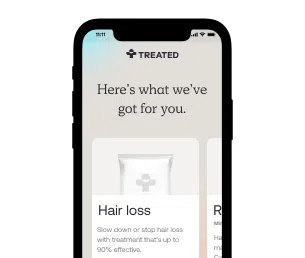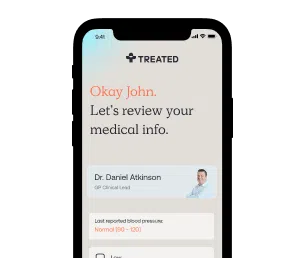Contraceptive patch
The birth control you only need to remember once a week.
Secure delivery
UK clinicians
The birth control patch. You only need to change it once a week. So it’s ideal for women who don’t want to take a pill every day.
Talk to us to get birth control options suited specifically to you. Choose which birth control you’d like and order your contraceptive patch online.

How we source info.
When we present you with stats, data, opinion or a consensus, we’ll tell you where this came from. And we’ll only present data as clinically reliable if it’s come from a reputable source, such as a state or government-funded health body, a peer-reviewed medical journal, or a recognised analytics or data body. Read more in our editorial policy.
When used correctly (as directed on the package insert), the patch is over 99% effective. This means that within a year, out of 100 women using the patch, fewer than one of them will become pregnant.
Correct use requires taking off the patch when you need to and replacing it at the right time, including after your patch-free week is over and you’re starting a new cycle. But correct use isn’t always possible. Life happens.
When life happens, it’s called ‘typical’ use. This includes forgetting to change the patch, or putting it on late, or the patch coming off by mistake. When used “typically”, the patch is still around 91% effective. So that means 9 in 100 women using it will get pregnant over a whole year.
When you should start using the patch depends on whether you’re already using hormonal birth control.
If you haven’t been using other birth control methods, you can start using the patch on the first day of your period — or any day of your period up until the fifth day. You’ll be protected against pregnancy straight away.
If you start on any other day, you won’t be protected immediately and should use a back-up birth control method like condoms for a week. That gives the hormones in the patch enough time to become active.
When switching from the combined pill to the patch, put the patch on one day before your pill-pack finishes. If you’re changing from the contraceptive ring to the patch, you should put on a patch two days before removing the ring.
You can wear the patch on your thighs, buttocks, upper outer arm or upper body. Just make sure to place it on clean, unbroken skin. Don’t place the patch on dry, irritated or cracked skin.
Wherever you place the patch, make sure that it won’t be rubbed by tight clothes. This could make the patch less sticky, causing it to fall off. Be careful when applying lotions, creams or powders to the area where the patch is too.
When it’s time for you to take your patch off and put on a fresh one, you should place your new one on the opposite side of your body. Change your placement each week. If you’ve just worn your patch on the left side, wear the next one on your right.

How we source info.
When we present you with stats, data, opinion or a consensus, we’ll tell you where this came from. And we’ll only present data as clinically reliable if it’s come from a reputable source, such as a state or government-funded health body, a peer-reviewed medical journal, or a recognised analytics or data body. Read more in our editorial policy.

How we source info.
When we present you with stats, data, opinion or a consensus, we’ll tell you where this came from. And we’ll only present data as clinically reliable if it’s come from a reputable source, such as a state or government-funded health body, a peer-reviewed medical journal, or a recognised analytics or data body. Read more in our editorial policy.
Have something specific you want to know? Search our info below, or ask our experts a question if you can’t find what you’re looking for.
Estrogen and Progestin (Transdermal Patch Contraceptives): MedlinePlus Drug Information.

Registered with GMC (No. 4624794)
Meet Daniel
Registered with GPhC (No. 2202465)
Meet Sanjeda
Registered with GPhC (No. 2070724)
Meet Craig
Always read the leaflet that comes with your medication and tell us about any side effects you get.
We know health, but you know you.
Our experts tell you what’s safe, but you decide what’s best.
Answer a few questions and tell us about yourself. Get tailored advice from our clinicians so you can choose better.

Choose your treatment and how often you have it delivered.

We know things change. It’s the nature of life. We’ll check in regularly to make sure your treatment is still right for you.
Pause. Change. Skip. Start again. Any time you like.
Here are some other things we can help with.
Personalised advice. Effective antibiotic treatments to restore balance. Get the help you need for BV.
Pill, patch, ring. We offer a range of birth control options so you can choose the one that's right for you.
Treatments to make your period lighter and more manageable. We'll help you to find the right option for you.
Prevent unplanned pregnancy with emergency contraception. Highly effective Plan B treatments, delivered fast.
Event planned? Period due? Take period delay pills a few days before to delay your bleeding.
Get tailored advice from our expert team, and choose from a range of treatments to reduce symptoms.
We're making healthcare more about you. Sign up to our newsletter for personalised health articles that make a difference.
Disclaimer: The information provided on this page is not a substitute for professional medical advice, diagnosis, or treatment. If you have any questions or concerns about your health, please talk to a doctor.
We couldn't find what you're looking for.
Here's everything we treat. Or, if you're looking for something we don't have yet, you can suggest something.
If there’s a particular treatment or condition you’re looking for, tell us and we’ll look into it for you.
Submit your question here, or tell us if you’ve found an issue on our site.
We’ll get back to you very soon. We aim to respond to all queries in one working day.
You’re signed up to our newsletter. Keep an eye on your inbox for our latest update.
By clicking 'Subscribe now' you're agreeing to our Privacy Policy.
We’ve sent you an email asking you to confirm your email address.